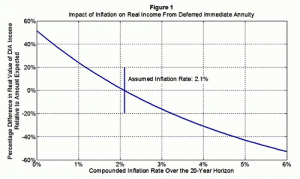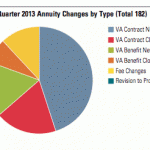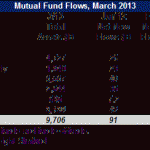By Kenneth Rogoff
At least for now, the rest of the world has confidence in America’s capacity to put its house (of representatives) in order. No one can imagine that a country with so many economic advantages would risk such a damaging self-inflicted wound as default would cause, writes the noted Harvard professor.
By Kerry Pechter
People are entitled to their own opinions but not to their own sets of facts, the scholar-politician Daniel Moynihan famously said. A collision of two versions of the “facts” about the government’s finances is part of what lies behind the current stare-down in Washington.
By Editorial Staff
The projection by some that 43 million Americans could lose their employer-sponsored health insurance when the Affordable Care Act becomes law is not backed up by the evidence, according to health economists at the University of Michigan.
By Mohamed A. El-Erian
We have a "highly-segmented, multi-speed" workforce in the U.S., writes PIMCO's CEO. While the unemployment rate of college graduates is only 3.5%, the unemployment rate for those without a high school degree is 11.3% and the teenage unemployment rate is over 22%.
By Editor Test
The ratio of savings to annual retirement income is roughly 20 to one. Twenty-to-one is an easy ratio to remember. Promoting it would be cheaper and easier than requiring a falsely-precise number for retirement plan quarterly statements.
By John McCarthy
Morningstar's Annuity Solutions product manager provides a review of changes to variable annuity contracts in the second quarter of 2013. Transamerica issued 32 new contracts and The Hartford closed 22.
By Allan Meltzer
"I am puzzled, and frankly appalled, by the Fed’s failure to explain how it will restore its balance sheet to a non-inflationary level. The announcements to date simply increase uncertainty without telling the public anything useful," writes this Carnegie Mellon professor.
By Editor Test
How I ruined a $250,000 mutual fund sale for a pair of Primerica reps, disrupting a transaction that may have been suitable but definitely wasn't fiduciary.
By Kenneth Rogoff
"If normal times call for a conservative central banker who helps to anchor inflation expectations, now is the rare time when we need a more unorthodox central banker who will fight deflation expectations," writes the professor of economics and public policy at Harvard.
By Kerry Pechter
The primary funding method for New York Life’s book of GFIA business, which has an average initial premium of $100,000, is via a rollover from another qualified plan. So far, the primary funding method for GFIA policies with an initial premium of $5,000 is through IRA contributions.
By Kerry Pechter
"Whether in taking out a student loan, buying a house or saving for retirement, people are being asked to make decisions that are difficult even if they have graduate training in finance and economics. Throwing the financially illiterate into that maelstrom is like taking students currently enrolled in driver’s education and asking them to compete in the Indianapolis 500." -- Richard Thaler, writing in the New York Times, October 5, 2013.
By Editor Test
Do Americans choose to marry, as opposed to cohabitate, so that they can invest heavily in their children’s futures?
By Editor Test
The new tool is designed to help advisors in “more deeply engaging their clients around plan actions," the Powhatan, Va.-based firm said in a release.
By Editorial Staff
Brief or late-breaking items from Cetera, Nationwide and New York Life.
By Editor Test
RIJ is sponsoring an award for Innovation in Retirement Income, to be given by the Retirement Income Industry Association. We've extended the deadline for nominations to Wednesday, September 11.
By Editor Test
Only 16% of resources (budgets, headcount and management) are devoted to young investors, and only eight percent of firms offer a dedicated young investor focus similar to retirement income, according to the Boston area research firm.
By Editor Test
“If economic conditions improved broadly as expected, the Committee would moderate the pace of its securities purchases later this year. And if economic conditions continued to develop broadly as anticipated, the Committee would reduce the pace of purchases in measured steps and conclude the purchase program around the middle of 2014.”
–Minutes of the Federal Open Market Committee, July 30-31, 2013.
By Editor Test
Improvement in the corporate earnings outlook and supportive valuations were positive indicators for stocks, the report from Prudential global investment strategist John Praveen said.
By Michael Wilson
"We suspect there will be occasional corrections in equities as they adjust to higher rates, but we would use those pullbacks to add to growth stocks in the US, as well as to European and Japanese equities," writes the chief investment officer of Morgan Stanley Wealth Management.
By Editor Test
Clients were likely to refer people to advisors who “set realistic expectations about investments returns,” “delivered on what was promised,” “achieved strong investment performance” and “disclosed their fee levels.”
By Editor Test
Many "military families are concerned about the increased possibility of involuntary separation and... worry that changes to military retirement benefits will encourage fewer years of service,” according to a survey by First Command Financial Services.
By Editor Test
On average, retirees without employer-sponsored health coverage must navigate among 31 prescription drug plans (Part D) and 20 Medicare Advantage plans. Their financial advisors can help them do that.
By Editor Test
Independent broker dealers, independent advisors/planners, and career agents all hold similar views toward and preparation for succession, a new survey shows. Advisors' hesitation in planning may come in part from not knowing how they want to retire from their practice.
By Editor Test
ThinkAdvisor.com is an enhancement of three-year-old AdvisorOne.com, Summit's online hub for financial advisors.
By Editor Test
“The strong enthusiasm for equities should give contrarians pause,” said David Santschi, TrimTabs' CEO. “Four of the ten largest inflows into U.S. equity funds occurred at the peak of the technology bubble in early 2000.”
By Editor Test
ETF sponsors should focus on new advisors in order to further increase advisor adoption, Cerulli recommends. More advanced educational initiatives will help increase ETF allocations among advisors who already using ETFs.
By Editor Test
The article referenced sentiments expressed by Alicia Munnell, director of the Center for Retirement Research at Boston College, regarding TIAA-CREF's decision to lower the fees of one of its defined contribution investment options.
By Editor Test
“The aftermath of the three-decade-long decline in interest rates is likely to be labeled a secular bond bear market, but we prefer to view it in the context of the cyclical normalization of interest rates,” said Richard Hoey of BNY Mellon.
By Editor Test
“Principal-agent problems and a flawed theory and understanding of finance are bringing capitalism to its knees,” says Paul Wooley of the Paul Wooley Centre for the Study of Capital Market Dysfuntionality at the London School of Economics.
By Editor Test
“We need to start segmenting the Boomer cohort,” said Cathy Weatherford, IRI President and CEO. While 42% of early Boomers believe they've saved enough for retirement, only 25% of Boomers between ages 50 and 55 believe they have enough.
By Editor Test
"As part of the settlement... Cigna has agreed to continue not to include in the plan's investment lineup any investment options managed by it or its affiliates and has agreed to continue to exclude retail class mutual funds from the plan's lineup—as it has since the 1990s," said a press release from the plaintiff's attorneys.
By Editor Test
The equity rally is likely to resume as the liquidity and policy uncertainties ease with the Fed reassuring about QE buying continuing through late 2013, writes John Praveen, chief investment strategist at Prudential International Investment Advisers LLC.
By Editor Test
“Only occasionally will they use professional advisors,” said Laura Varas, Hearts and Wallets principal. “ certain key moments open the door for the advisor relationship.”
By Editor Test
“The tool supports insurance industry participants as they navigate this increasingly complex web of regulations and agent training requirements that differ across states and product lines,” said a DTCC release.
By Editor Test
Asked to project which asset class will perform best this year, the top choice among institutional investors was global equities (27%), followed by domestic stocks (19%) and emerging market equities (15%).
By Editor Test
More than 80% of advisors reported in a Curian Capital poll that they have access to adequate investment products to meet their clients’ retirement income needs.
By Editor Test
“If DC plans were constructed more similarly to DB plans, approximately 20% of the DC plan assets would be allocated to non-traditional strategies such as real assets, total emerging markets (which combine equities and fixed income) and liquid alternatives,” BNY Mellon said in a release.
By Editor Test
Resources on the platform will be organized by Pershing's practice management “pillars”: Growth, Human Capital, Operational Efficiency and Managing Risk.
By Editor Test
56% of high net worth investors still hold lots of cash, according an extensive study of Americans with over $3 million by U.S. Trust. Just 12% like 'sitting on the sidelines,' but only 16% plan to move their cash soon. Two in five plan to gradually invest cash over the next two years; 35% have no plans to invest it.
By Editor Test
"The major challenge facing advisors today isn’t analysis, it’s prospecting," claims David Macchia of Wealth2k. His company's new product for advisors combines Social Security claiming analysis and a prospecting strategy into a single content-marketing tool.
By Editor Test
A recent LIMRA-CANNEX study, 'Features in Income Annuities—Immediate and Deferred Income Annuity Designs,' noted differences and similarities of immediate and deferred income annuities.
By Editor Test
Representatives from MetLife and its affiliates “will have access to a broad portfolio of non-proprietary products that offer a full spectrum of life-related insurance solutions for their clients, leveraging Crump’s tools, services and technology,” a release said.
By Editor Test
The three-day course will be held in New York City on July 16-18. It will focus on “dynamic risk budgeting approaches” and “reconciling strict risk budget management with implementation of optimal long-term allocation.”
By Editor Test
It was the highest quarterly total since the first quarter of 2012, when 17 deals were closed totaling $24 billion in AUM.
By Editor Test
Serious health problems, dependency on one’s family, and outliving assets ranked among American's top concerns when asked about their views on living a long life (72%, 60%, and 47%, respectively), according to a new Merrill Lynch/Age Wave survey.
By Editor Test
The integrated solution will be available from Envestnet in June 2013. HiddenLevers is a New York-based financial technology company that builds risk management and macro-economic analysis tools.
By Editor Test
Sales of Elite Access were $1.3 billion in 2012, the company said. Jackson’s total VA sales in 2012 were $19.7 billion, up from $17.5 billion in 2011.
By Editor Test
Just over half of investors polled say now is a 'good time' to invest in the financial markets, up from 39% in the fourth quarter of 2012 and at the same level as February 2012.
By Editor Test
The Highest Daily (HD) VA now offers 21 asset allocation portfolios in four strategies (traditional, tactical, quantitative and alternative).
By Editor Test
“I think this is a good thing, because so many people have so little saved for retirement,” said Kathleen Wolf, finance chief at Atari International Contracting, a small construction firm. “But forcing it is like adding another layer of Social Security."
By Editor Test
“Investors seem convinced the Fed has their back. They snapped up equities across the board as the Fed pumped an average of $4 billion per business day of newly printed money into the financial system," said TrimTabs' David Santschi.
By Editor Test
Older investors are moving from cash to bonds, and younger investors from bonds to stocks. These "rotations" should persist, says Avi Nachmany of Strategic Insights.
By Editor Test
The PBS television series, "Frontline," will focus on 401(k) and IRAs on April 23. Judging by the 30-second preview (click headline to see link), "The Retirement Gamble" will be critical. Comments of Jack Bogle are featured.
By Editor Test
People often trust their financial advisors to the extent that they “understand how the advisor and firm earn money,” according to the Boston-area research firm.
By Editor Test
The top wealth (and income) groups saw the percentage increase in their net worth (and non-home wealth and income) rise rapidly from 1983 to 2010. The top one percent received 38% of the total growth in net worth between 1983 and 2010.
By Editor Test
Clients using 'Retirement Picture' develop visuals of retirement lifestyle scenarios through a series of interactive screens. Users choose scenarios of interest and gauge their retirement risk preparedness for each.







